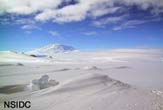Lunar Cycle Changes Ice Stream Flow

From temporary lunacy to werewolf awakenings, the lunar cycle has seen its share of blame. Now, scientists say that the different phases of the moon influence the flow of a massive ice stream in Antarctica.
The Rutford Ice Stream—a river of ice larger than the Netherlands which drains the West Antarctic Ice Sheet—varies its speed by almost 20 percent every two weeks, scientists report in the Dec. 21 issue of the journal Nature.
The change coincides to the bi-weekly tidal cycle when the gravitational pull of the Moon and the Sun are either working together or working against each other.
When the gravitational pull of these two heavenly bodies combine, we get the exceptionally large spring tides. When the Moon and the Sun are at right angles to each other and their gravitational pull partially cancels each other out, small neap tides arise.
“We’ve never seen anything like this before,” said study author Hilmar Gudmundsson, a researcher at the British Antarctic Survey. “The discovery that the spring-neap tidal cycle exerts such a strong influence on an ice stream tens of kilometers away is a total surprise. For such a large mass of ice to respond to ocean tides like this illustrates how sensitively the Antarctic Ice Sheet reacts to environmental changes. Glaciologists need now to rethink how the Antarctic Ice Sheets reacts to external forces.”
Further research is needed to determine if this is an isolated case or if tidal motion affects other ice streams.
· All About Antarctica
Sign up for the Live Science daily newsletter now
Get the world’s most fascinating discoveries delivered straight to your inbox.
· Meltdown: Ice Cracks at North Pole
· Beach Pollution Worse During Full Moon
· VIDEO: Nature Presents: Under Antarctic Ice
· The Weirdest Science Stories of 2006










